Menu
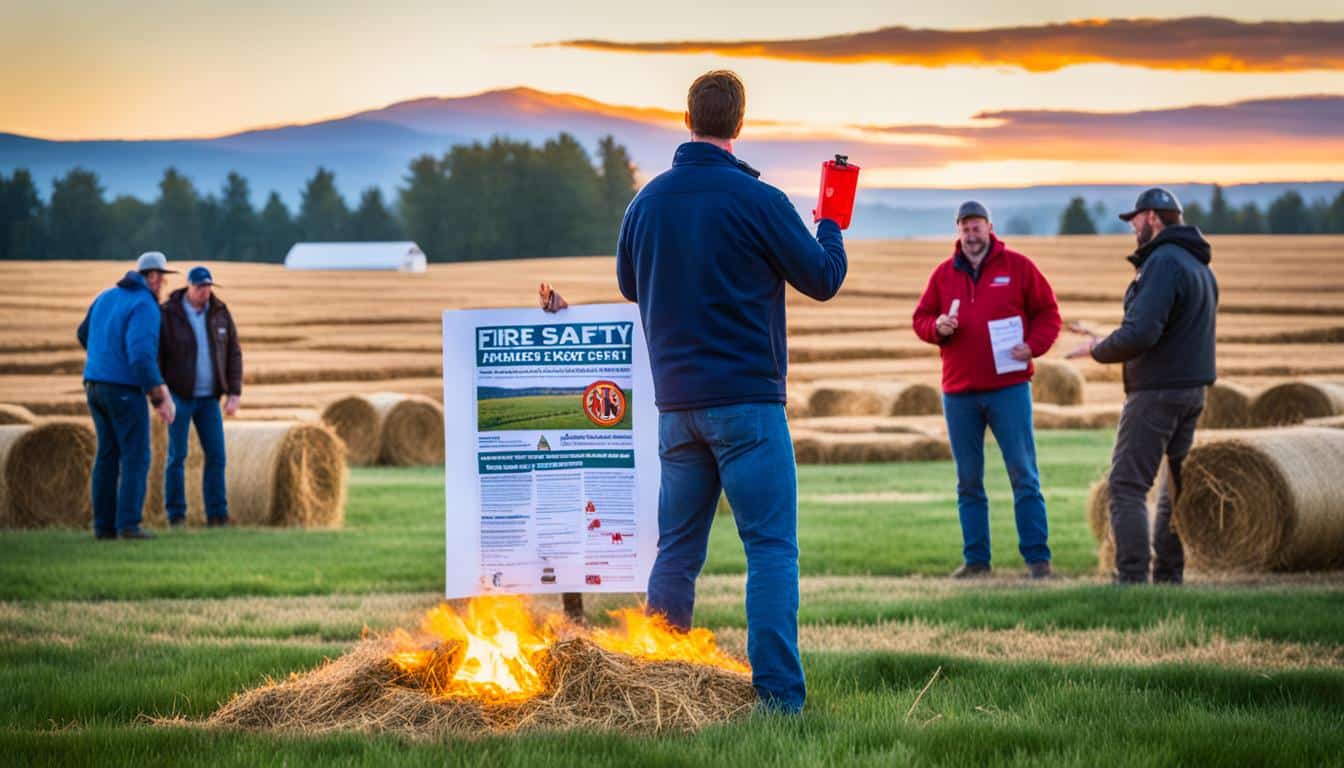
Is your farm ready to fight off fire risks? Kelly Grummert, the director of Nationwide Risk Management, warns about big machinery fires on farms. They cause huge property damage, lost work time, and injuries every year. This makes clear how vital fire safety is on farms.
Preventing, detecting, and stopping fires are key on farms. Regular checks on machines are crucial. These checks help avoid dangers by keeping machines clean and in good condition. They also mean crops and fluids won’t catch fire easily.
Keep machines away from anything that could start a fire. Use smart technology to watch for any smoke or rise in temperature. It’s also important to have fire extinguishers placed where they can be quickly used. These steps are essential for keeping farms safe from fire.
It’s crucial to know the complex nature of farm fire risks. This knowledge helps protect farms and set up good prevention methods. Farms can face fires from many sources, making it vital to manage risks well.
Farm fires come from different places, each with its own dangers. Things like sparks from machines, embers, and hay that catches fire on its own are common. The National Fire Protection Association notes that summers see many farm fires due to electrical storms and hot hay. Winters bring fires from appliances, rodents, or built-up dust, with barn heaters often as the main issue.
During 2013-2017, the NFPA reported that barn fires caused one civilian death per year, along with ten injuries, and $28 million in property damage.
The danger is especially high in areas where machinery is kept and serviced. Fluid leaks, leftover crops, and heat sources nearby can lead to fires. Half of barn fires destroy everything, showing the need for strict safety rules. Barns store many flammable materials, which help fires spread quickly.
Things like gas, oil, and aerosol cans make fires spread faster. Cigarettes, matches, and machine sparks are often the causes. To stay safe, use fire-resistant materials, fit smoke alarms and sprinklers, and have water nearby.
| Season | Common Causes |
|---|---|
| Summer | Electrical storms, spontaneous hay combustion |
| Winter | Appliances, rodent activities, dust accumulation |
Preventing farm fires means working hard to follow these strategies. Keep things well-maintained, stored correctly, and watch out for things that could start a fire. Doing so can lessen the chance of a fire and lessen the harm if one happens.
Keeping farm operations safe and efficient means using strict farm fire safety measures. It’s key to check and maintain farm machinery often to avoid fire dangers.
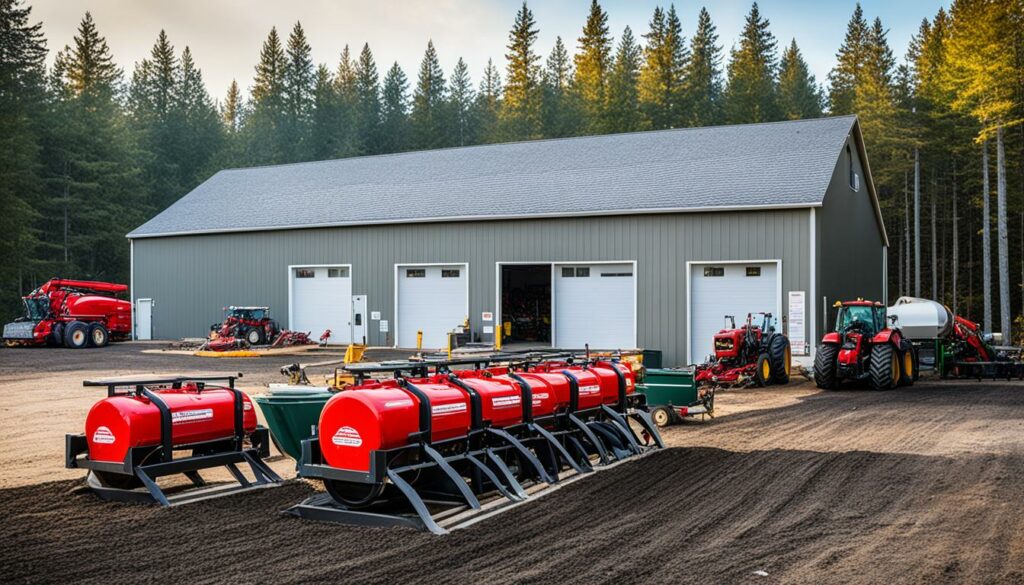
It’s vital to inspect farm equipment regularly to catch fire hazards early. Machinery fires on farms are a big risk. But, with regular checks, most can be stopped before they start. Be sure to look over hoses and fittings to stop leaks and avoid fires.
Having fire extinguishers on your machinery is money well spent. Their cost is almost nothing compared to buying a new machine. Check all extinguishers often to make sure they work.
After harvest, clean off all dirt and keep engine fluids away. This lowers the chance of fires. Make sure all parts are well oiled and replace any that are worn. Fix things like wiring and exhausts straight away.
Stay safe when refuelling. Always turn off the engine and let it cool down before filling it up. A bad exhaust system can cause fires, especially in dry fields.
| Maintenance Task | Frequency | Fire Safety Importance |
|---|---|---|
| Inspect Hoses and Fittings | Weekly | Prevents leaks and potential fire risks. |
| Check Fire Extinguishers | Weekly | Ensures readiness to handle fires. |
| Clean Off Crop Residue | After each use | Reduces combustible materials near heat sources. |
| Lubricate Bearings and Gears | Per Manufacturer Guidelines | Minimises friction that could lead to fires. |
Sticking to farm fire safety measures with regular checks and good cleaning cuts the risk of machinery fires. This kind of careful and ongoing care keeps farm equipment working well. It also protects the livelihoods that rely on it.
Keeping barns safe from fire is crucial to protect what’s inside and the people around. The NFPA shows barn fires are a big risk, causing harm to people and costing a lot in damage. To lower the chance of barn fires, it’s key to spot dangers and handle flammable items with care.
First, it’s important to spot what items might start a fire in a barn. Studies show things like hay, straw, bedding, cobwebs, and even horse blankets can be very dangerous. Materials like gasoline and oils can make fires worse. Then, things that can start a fire, like cigarettes and electrical equipment, add to the risk.
It’s crucial to know how to safely store flammable stuff. This means keeping such items away from heat and making sure hay can breathe to avoid heating up enough to ignite itself. Checking the temperature of hay is good to prevent it from catching fire. Plus, making sure all electrical systems are safe is a must, especially in old barns.
Adding certain safety items can help lower the fire risk in barns and cut down on insurance costs. For instance, fire-safe doors, firewalls, fire-resistant material, and special paint can all protect against fire. Plus, smoke alarms, sprinklers, and lights that work even when power is out are very useful.
To keep barns safe from fire, there are some basic steps to take. These include not allowing smoking, making sure walkways are clear, and keeping hay and manure far from the barn. It’s also important to keep the barn clear from too much plant growth and mess to reduce fire risk.
Thermal imaging is getting better by the day, catching heat issues early to prevent fires on farms. The Teledyne FLIR thermal systems are top picks for their precision and trustworthiness. This tech lets farmers see problems before they turn into big fires.
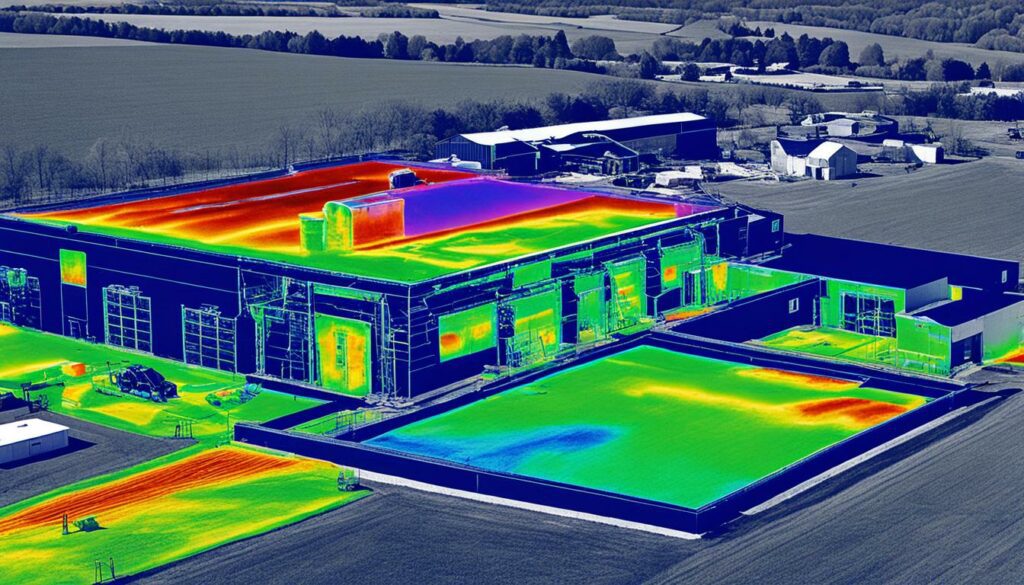
It spies on heat our eyes can’t see, thanks to infrared sensors. The PYROsmart system, with FLIR A-Series cameras, finds fires fast in risky spots like areas with dry wood or batteries. It can even make a big picture out of smaller snapshots, showing a whole farm to help keep it safe.
Thermal imaging brings many benefits. It can sound an alarm if things get too hot, leading to quick action. For example, the PYROsmart system is helping cut down fires in places that burn waste or make cokes. This means fewer fires and less damage.
Less water is needed to fight fires in cokes plants too, from 8% down to just 2%. This saves water, improves what the plant makes, and earns more money. Plus, the PYROsmart system is so good at finding where a fire starts that it uses less water and causes less harm than old sprinklers. So, it’s a smart investment against fire losses.
| Benefits | Impact |
|---|---|
| Early Fire Detection | Minimises damage and risk of injury or death |
| Automatic Alarms | Enables prompt intervention |
| Water Usage Reduction | Conserves resources and improves product quality |
| Precision in Targeting Fires | Minimises destruction and wastage |
| Cost-Effectiveness | Prevents material and human losses |
Farm fires are a big worry, with about 830 barn fires yearly from 2006 to 2010. These fires cost around $28 million in damage each year. They also hurt or killed people. That’s why having *fire safety equipment* like farm fire extinguishers is so important. They help respond fast to fires and lower the risk of big disasters.
Different fires need different tools to put them out. In farming, the main ones you need are:
Where you put extinguishers and how you care for them matters a lot. This keeps farms safer from fire:
Keeping farms safe from electrical system safety problems is crucial. Barn fires often start with these issues. The NFPA says, between 2013 to 2017, 326 deadly barn fires happened every year. These caused one death, ten injuries, and £28 million in damage each year.
Moisture, dust, and rodents make farm electrical hazards worse. Good upkeep and setup of electrical systems can lower the fire risk on farms. There are key steps to take for better farm electrical safety:
Barn fire risks go up in summer and winter. Summers can bring electrical storms and hot hay fires. Winters see fires from appliance use, chewed wires by rodents, or dust. Insurers may offer cheaper rates for farms with extra fire safety steps. This shows how vital being proactive is.
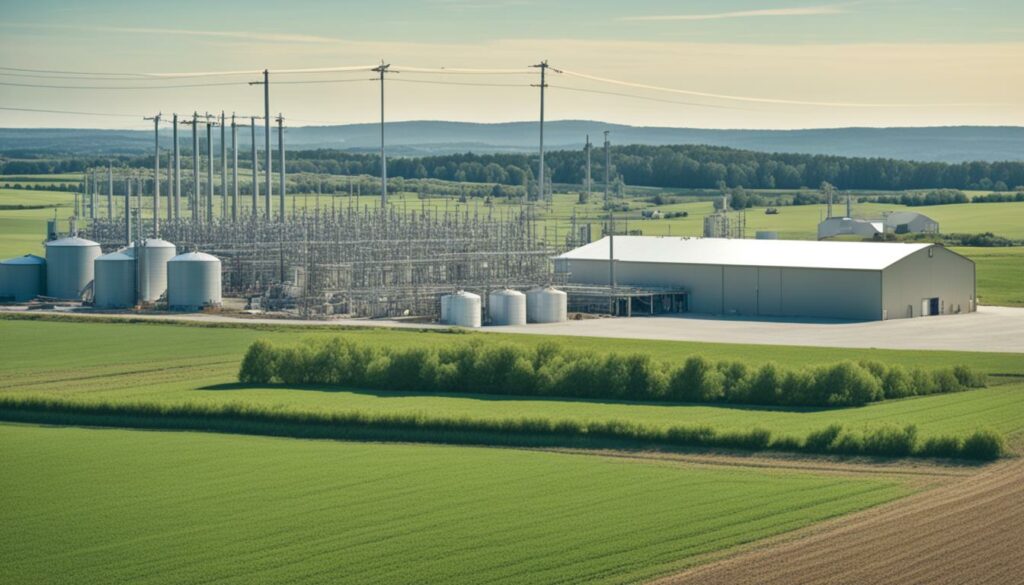
Barn motors, like fans and water pumps, need waterproof on/off switches. Electric fences, especially those with continuous current, pose fire risks. It’s also key to use heat lamps correctly to prevent them from causing fires.
Regular checks and key safety steps are crucial. These include using lightning rods and keeping manure piles at least 20 feet away from barns. Having ABC dry-chemical fire extinguishers in places like livestock buildings is also important.
By following these electrical safety precautions closely, we can make farms safer. This helps cut the risk of fires and avoid common farm electrical dangers.
Putting fire detection systems on farms is vital for safety. It includes smoke detectors and fire alarms. These help give an early warning and quick response to fires. This protects both things and people on the farm.
Many fire detection systems work well on farms:
Setting up fire detection systems the right way improves their power. Here are important tips:
Besides these systems, using other tools like fire extinguishers helps too. Farmers can make their farms safer by using these tech and keeping them in good shape.
Want more farm fire safety tips? Check out this fire safety brochure. It covers a lot of helpful information.
It’s very important to plan for a possible farm fire emergency. This protects both people and property. Fires grow fast, turning a smoke-filled barn into a blaze in just minutes. To stay safe, plan ahead and make sure everyone knows what to do.
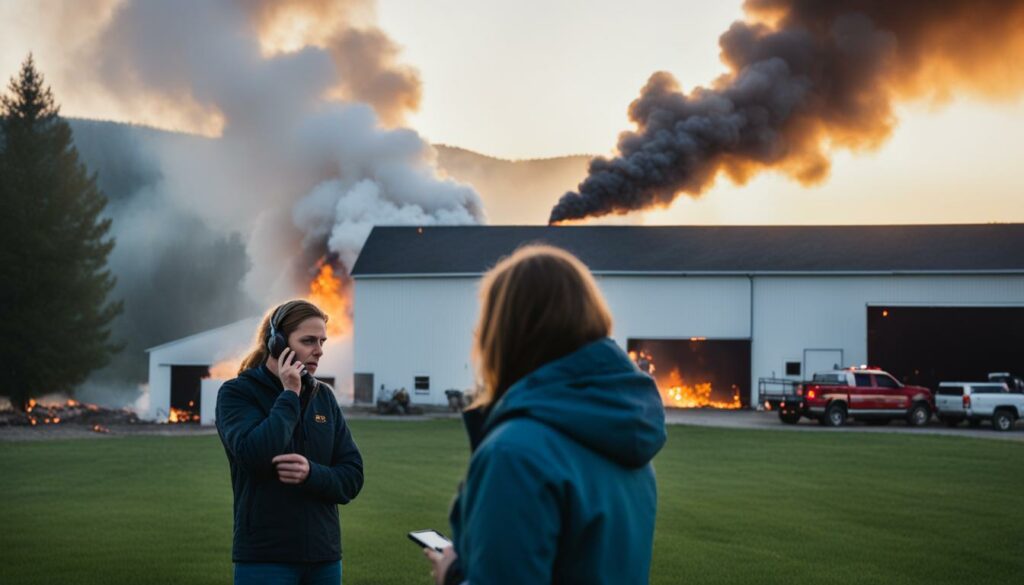
A good farm fire emergency plan has many parts. It starts with knowing how to call for help. Make sure all buildings have two ways out. Keep fuel and other flammables at least 40 feet from structures. Everyone should know the best way to leave, for people and animals. Checking for dangers with thermal cameras is smart too.
| Component | Details |
|---|---|
| Emergency Contacts | Contact emergency services and the local fire department |
| Exits | Ensure all buildings have at least two exits |
| Evacuation Routes | Create and chart evacuation routes for personnel and livestock |
| Inspections | Use thermal cameras to identify fire hazards |
Training everyone is key. They should know how to use fire extinguishers and spot alarms. Practising evacuation is vital. This means they can act fast to prevent harm.
To sum up, being ready for a fire is essential for farms. With fire safety training and clear evacuation steps, everyone can help. This care saves both lives and the farm itself.
Livestock are vital to any farm. It’s critical to keep them safe from fires. Knowing how to protect them and having a plan to move them out can lower the danger. It’s also vital to meet the specific needs of different animals to keep them safe.
It’s important to have a well-thought-out evacuation plan. This is to reduce the harm from barn fires. With 326 deadly barn fires happening each year from 2013 to 2017, it’s clear that a good plan can save lives. A success plan includes:
Including fire safety in the farm’s overall emergency plan is very important. This way, all aspects of animal safety are covered.
Every kind of animal needs a unique approach during a fire. Here are guidelines for some animals:
Using protective equipment like enclosed heat lamps and sturdy bulbs is a must. They help to stop fires starting, which is a big risk in barns. Also, investing in electrical safety features like Arc Fault Interrupter breakers can protect animals and farms further.
Taking part in the Farm Emergency Response Program by NYCAMH is very helpful. It teaches about being ready for emergencies, first aid, and how to deal with fires. This makes farm owners better prepared against fire dangers.
| Fire Safety Tips | Description |
|---|---|
| Higher Quality Heat Lamps | Buying heat lamps that are enclosed, like those from Premier, can lower the risk of fires if they drop. |
| Hard Glass Bulbs | Using sturdy glass bulbs, such as 175w bulbs from Farmerboy Ag. Supply, makes them safer by not breaking easily. |
| Arc Fault Interrupter Breakers | Switching to Arc Fault Interrupter breakers is more expensive but they offer better protection. |
| Emergency Response Training | Training in fire safety, being ready for emergencies, and first aid is essential. |
It’s vital to manage hay well to lower fire risks. To do this, hay must be cured and stored correctly. This can help cut the chance of hay catching fire on its own. We’ll look at what causes hay fires and how to store hay safely.
Hay fires often start due to too much moisture. This can make hay catch fire by itself. For small bales, the moisture level shouldn’t be above 20 percent. For bigger bales, like squares or rounds, it should stay below 18 percent. Hay is at the highest risk of fire within six weeks of being baled. The weather to dry hay well is slightly windy and not too humid.

To prevent fires, storing hay well is key. Bales should be as dry as possible, with a moisture content under 20%. It’s also best to keep hay under cover. If hay’s stored outdoors, make a clear area around it for about 15 feet to avoid fires.
Another important step is to watch the stored hay’s temperature. Using devices like the HAYTECH platform can give warnings if the hay gets too hot. If you see any sign of smoke or unusual smells, call the fire brigade. Also, talk to experts in hay safety, like those at Nationwide Farm Certified or with the local agriculture extension.
When moisture in hay goes over 25%, it’s more likely to catch fire. So, harvesting and drying hay correctly is a must. By keeping an eye on the hay and looking out for any dangers, you can make a farm safer from fires. This is a big step in avoiding big losses.
| Cause | Preventative Measure |
|---|---|
| Excessive moisture | Ensure hay is baled at correct moisture content |
| Spontaneous combustion | Store hay under a roof, create firebreaks |
| Overheating | Monitor temperature using tools like HAYTECH |
| Unusual odours or smoke | Investigate immediately to prevent flare-ups |
Setting up good fire break strategies is key for farm fire prevention. By putting buffer zones around farm land, we can lessen how much fire moves into or out of the area.
The first step to create these buffer zones, or safe zones in agriculture, is to clear flammable stuff near farm buildings. This means removing dried plants, fuel, and other burnable items. Keeping these areas clean not only cuts fire risk but also helps trees grow better because they get more space.
Firebreaks are important by making wildfires less fierce. They slow down fire spread and break up the fuel. A lot of work goes into setting these areas up and keeping them that way. Tasks might include:
It’s also very important to have clear access routes. This lets emergency crews get to where they’re needed fast. It makes things safer for firefighters and helps handle fires better.
Though the effort and cost for these practices can change, they are essential. They ensure the farm is safe and can keep running well.
Focusing on fire break strategies doesn’t just lower farm fire risk. It also makes farm areas safer for both people and animals.
Implementing fire prevention measures on farms is vital for safety. A key step is keeping farm equipment in good shape. Faulty heating gear is a top cause of farm fires. Checking and fixing them often can cut this risk.

It’s also crucial to have good fire alarms. Apart from the usual smoke detectors, adding fire sprinklers is smart. Install them in barns, machine areas, and every key spot. This early alert system can stop fires from growing too big. Farm buildings should also have plenty of exits and fire extinguishers nearby.
Farm safety means storing things like fuel right. By following the maker’s storage advice, you lower the chance of fires. Making sure work areas are well-ventilated is another must. It cuts down on gases that could cause fires.
Creating safe areas and firebreaks is another step. These buffer zones, free from stuff that burns easily, protect buildings. Also, making sure emergency routes are clear helps fire crews get in fast. Using special fire-safe materials in buildings is wise too.
Barns need careful upkeep too. Protecting wiring from harm, like animal bites or bad weather, is essential. Electrical checks each year by a pro can spot dangers early. Keeping electrical boxes dry and using special plugs adds to safety.
Late nights and early mornings are high-risk times for farm fires. Within a few minutes, a barn can fill with smoke or flames. Knowing what to do and practising fire drills are key to being ready for any fire.
| Aspect | Preventative Measure |
|---|---|
| Heating Equipment | Regular Inspection and Servicing |
| Fire Detection Systems | Installation of Smoke Detectors, Fire Alarms, Sprinklers |
| Hazardous Materials | Proper Storage and Handling |
| Ventilation | Adequate Ventilation in Work Areas |
| Construction Features | Use of Fire Doors, Walls, Flame Retardant Materials |
| Electrical Safety | Annual Inspections, Moisture Protection, Ground Fault Receptacles |
By following farm safety protocols, farmers can make their farms safer. Tackling these steps lessens fire risks. It helps keep their farms smart and their work going strong.
It’s very important to work closely with fire departments for farm fire safety. By working together, farms and firefighters can respond better if a fire breaks out. This teamwork also means farms are safer overall.
To make sure farms are safe from fires, we need to talk regularly with the fire brigade. Sharing knowledge about fire safety helps everyone be prepared. This way, firefighters can quickly find their way around the farm.
Checking on safety regularly is key for fire prevention. Firefighters can check the farm for any dangers and give advice on how to stay safer. These checks help avoid common causes of farm fires, like heat lamps and bad storage.
Places like farm shops need extra attention. They should have fire extinguishers and clear rules for refueling. Keeping flammable things safe stops fires from spreading fast. By regularly updating safety plans, farms stay protected from fire dangers.
Preventing farm fires is crucial for a successful farm. Farms are at higher risk of fires because of hay, feed, and big machines. Good fire safety can stop or reduce damage to buildings, animals, and equipment. This helps keep the farm running smoothly.
Keeping the electrical system in good shape is very important. Wires should be safe in metal or PVC. Checking them yearly with a proper electrician can lower the chance of fires a lot. Also, fill up machines far from the farm buildings. This is great for making fires less likely. Storing fuel safely and checking fire extinguishers often are big steps for fire safety too.
Taking care of barns and buildings matters a lot. Keep them clean and well-organised to avoid dangerous gases. Make sure there’s enough fresh air and that heaters are safe. Teaching workers how to use fire extinguishers well is key. This makes sure everyone knows what to do if a fire starts.
Farms in the countryside might wait longer for fire help. So, following both national and local fire safety rules is a must. Keep away things that could start fires. Store flammable stuff safely and mark them clearly. Regular farm equipment checks are important too. Putting in a lightning protection system and storing hay well can also help avoid fires. These steps protect farms and make them safer.
Fires on farms start in many ways. This can happen from machinery sparks, embers, lightning, or from hay heating up on its own. Not handling these can cause a lot of damage.
Places where machines are stored and fixed are risky. Leaking fluids, leftover crops, and being close to heat sources make fires more likely. Dry conditions make bushfires and lightning in harvest time big dangers.
Inspecting machinery often is key to preventing fires. You should look for leaks, make sure machines are well-oiled, and clean up any leftover crop bits or fluids. Doing this reduces the chance of fires a lot.
After using machines, clean off all the leftover bits. Keep them away from heat sources until the next use. Always follow the maker’s advice for storing. Also, check for leaks or damage regularly.
Bedding that can catch on fire, faulty wiring, and machines that get too hot are big risks. It’s important to handle and store these things right, and to keep up with maintenance. This helps stop barn fires.
Store things that can burn away from heat and electricals. Keeping an eye on how warm hay gets and following fire safety laws make things safer.
Thermal imaging spots where machines might be getting too hot. It lets you take action before a fire starts.
It lets you find problems in machinery before they cause a fire. Using thermal imaging like from Teledyne FLIR can lower your insurance cost, too.
Different kinds of extinguishers tackle different fires. For things that normally burn, use Class A. For liquids, it’s Class B. For electricals, choose Class C.
Extinguishers should be easy to get to, like in the machinery cab. They should also be near possible problem areas. Check them often to make sure they work.
Keep electricals clean and dry to stop fires. Cover outlets, use metal around wires, and fit things right. These steps lower fire risks.
Choose from alarms, heat sensors, and smoke detectors. Pick what fits your barn’s needs for spotting fires early.
Put fire detectors in likely fire-starting places. Have alarms loud enough to hear everywhere. Keep them working well with regular checks.
Know who to contact in an emergency and how to get out safely. Think ahead about your animals and gear. Train everyone so they can act fast and smart.
Plan routes that suit different animals so everyone is safe. Keep your emergency plans practical to care for your livestock in a fire.
Hay can catch fire if it’s not dry or stored right, or around machinery that’s too hot. Making sure your hay is dry, well-stored, and away from sparks is key.
Make areas without things that can burn, keep spaces around buildings clear, and have ways for firefighters to reach you. This stops fires from spreading.
Keep up with machinery, fit fire alarms, and plan for emergencies. Look after your animals, manage what can burn, and work with your local fire service.
Teaming up with firefighters makes it easier to understand and act on safety advice. They can check your safety plans and help keep your farm up to code.